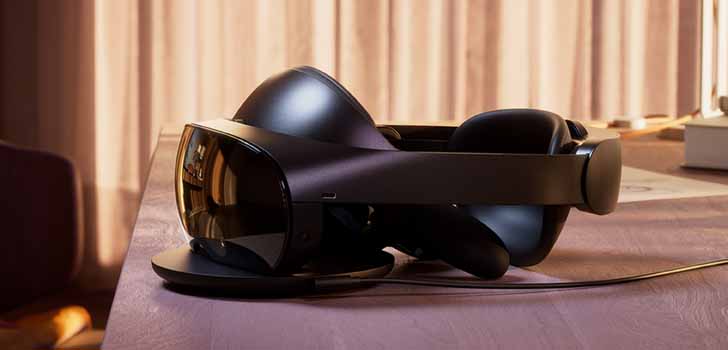Meta is preparing to launch its new Quest Pro headset and has finally revealed the details about pricing, release date, and technical specifications.
Developed under the name Project Cambria, the Quest Pro is the next generation in high-end standalone VR headsets.
The new headset features high-resolution sensors, improved optics, and full-color cameras for mixed-reality applications.
The Quest Pro also has 12 GB of RAM, a Snapdragon XR2+ chip, and 256 GB of storage space.
“We believe VR devices will help usher in the next computer platform—becoming as ubiquitous as laptops and tablets are today—and that people will use them in their everyday lives to access the metaverse,” says Meta. “With its cutting-edge technologies, Meta Quest Pro represents an important step toward that future. We designed it to expand the possibilities of both VR and mixed reality. And to do that, you need truly innovative hardware.”
Improved Optics
Meta says the Quest Pro’s optical stack lenses are an improvement over the Quest 2’s Fresnel lenses, featuring pancake optics that fold light several times over.
According to Meta, the lenses reduce the optical module’s depth by 40 percent and provide clear, sharp visuals.
The dual LCDs use local dimming and quantum dot technology for more vivid colors and 75 percent more contrast.
Meta says the new headset has 37 percent more pixels per inch, increased sharpness, improved peripheral region, and a 1.3-times larger color gamut than the Quest 2.
New Controllers
The Quest Pro also has a pair of redesigned controllers that self-track in 3D space, independent of the headset, because solid controller tracking is crucial in VR.
Stable controller tracking is something previous headsets have struggled with at times.
The controllers also have built-in rechargeable batteries and feature the upgraded TruTouch Haptics system for a wider and more precise feedback range.
As a bonus, the Touch Pro controllers, which you can purchase later this year for $299.99, are compatible with the Quest 2.
Enhanced Cameras
While Oculus/Meta headsets with inside-out tracking have featured passthrough cameras in the past, the ones in the Quest Pro have improved optics.
The new headset features high-resolution, full-color, outward-facing cameras with four times the resolution of the Quest 2’s black and white cameras.
The cameras allow users to see the outside world in color and 3D, facilitating endless mixed-reality applications.
The Quest Pro features an open periphery that allows users to stay present in the real world through peripheral vision.
For deeper immersion, Meta will release full-light blocker attachments for purchase later this year.
With pancake lenses and a curved-cell battery in the back, Meta calls the Quest Pro its slimmest and most-balanced VR device ever.
Eye and Expression Tracking
In addition to enhanced hardware tracking features, the Quest Pro can also track eyes and facial expressions.
Facial expression tracking, which can facilitate more-realistic avatar experiences, is turned off by default.
For privacy, Meta says eye and face images stay on the headset, disappear after processing, and are never shared with anyone.
Including Meta.
While the Quest 2, which debuted on September 16, 2020, retails for $499 (256 GB, USD), the Quest Pro will come with a much higher price tag at launch.
The Meta Quest Pro will include the headset, two Touch Pro controllers, stylus tips, partial light blockers, and a charging dock for $1,500 (USD).
The headset will be available for purchase on October 25 and can be pre-ordered from the Meta Quest store, Amazon (US, UK, Canada), Best Buy (US, Canada), Argos (UK), Currys (UK), FNAC (France), and Boulanger (France).

